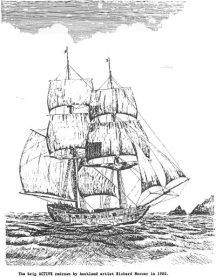The first horses in the last land
When ancestors of the modern horse, ass and zebra – Equus sp. – crossed the Bering Isthmus from North America to colonise Asia around 2.6 million years ago [1, 2]…
and were domesticated, initially largely for food, by peoples across Eurasia [3] between 4000 and 2500 years ago [4, 5]…
 to colonise the world as the agents and servants of empires, small and large, in warfare, transport and agriculture [6]…
to colonise the world as the agents and servants of empires, small and large, in warfare, transport and agriculture [6]…
who could have guessed their world expansion would end just 200 years ago in New Zealand – the last major landmass to receive horses.

The brig Active – carried the first horses, a stallion and two mares, to New Zealand to found and serve the Oihi Mission Station.
Equine landing
On the 24th December, 1814, a stallion and two mares [7]* were landed on the beach below Rangihoua Pa (fort) from the Rev. Samuel Marsden’s brig, Active, in front of local Maori – descendants of New Zealand’s first colonists from Polynesia.
“Mr Marsden, mounting the horse, rode up and down the beach, exciting their wonder in a tenfold degree. To see a man seated on the back of such an animal, they thought the strangest thing in nature; and following him with staring eyes, they believed at the moment that he was more than mortal.” – John Liddiard Nicholas [8].
First horses were not gifts to Maori
The first horses were not gifts of goodwill made years earlier by Major-General Lachlan Macquarie, the Governor of New South Wales, Australia, to local Maori chiefs, perhaps Ruatara – an often repeated story [9] even in late-20th century texts [10, 11].
There is, however, no reference to horses being sent before 1814 in earlier texts [12] and no mention of horses in earlier correspondence from Samuel Marsden to Ruatara, only “seed wheat and with implements of husbandry to cultivate the soil” [13].

The brig Active anchored in Rangihoua Bay, New Zealand, and unloaded three horses, a stallion and two mares, for the new Oihi Mission Station 24th December 1814. The earth works of the Oihi Mission Station can still be seen on the grassed slopes of the bay in this satellite image (source: http://www.googleearth.com). The terraced earthworks of Rangihoua Pa, that stood on the cliffs and steep slopes above the mission, can also still be seen (as labelled). Rangihoua Bay’s location is indicated by the red arrow in the insert of New Zealand.
Mission horses
In her excellent PhD thesis on the history of the horse in New Zealand [11], Dr. Carolyn Mincham could also find no evidence for ‘horses as gifts’. Rather, the written evidence suggests that the

Oihi Mission Station, New Zealand’s first, in Rangihoua Bay below Rangihoua Pa (Source: Rex Nan Kivell Collection, National Library of Australia)
horses were intended for the new mission station, Oihi. They were listed with a value of £80 in the Active’s expense accounts amongst the ‘necessaries for forming the settlement of New Zealand’ and accompanied by a saddle and bridle worth £5 [11].
Dr. Mincham thought them probably utility horses for pack, saddle and carriage work, perhaps even from the Rev. Marsden’s own stud in New South Wales. The Rev. Marsden was a major landowner and stock breeder in New South Wales. He sourced mares from other colonies and crossed them with his Thoroughbred stallion Champion.
Small beginnings
So the colonisation of the world by horses ended, and their colonisation of New Zealand began, on a small beach in the Bay of Islands when a new mission station was frunished with three horses –

Landing of the Rev. S. Marsden in New Zealand, Dec. 19, 1814. Wood graving by Samuel Williams (1788-1853). Source: Annals of the diocese of New Zealand, edited by Sir Charles Jasper. London, Society for the Promotion of Christian Knowledge, London, 1847. Alexander Turnbull Library, Wellington, New Zealand.
a pedestrian beginning for the transformation of this small nation by horse-power that was to come.
Notes:
*A horse aboard the Active is also recorded by Richard Taylor (1855) [14] but reference to only one horse is made.
Bibliography
6. Diamond, J.M. (1991) The earliest horsemen. Nature 350, 275-276.

Thanks for another fantastic piece. I am looking forward to your next blogs.